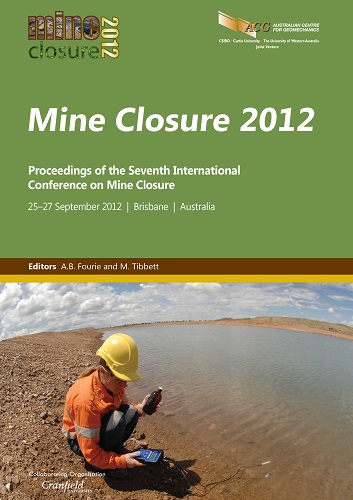Simulation of seven years of field performance monitoring at Rio Tinto Iron Ore, Mount Tom Price Mine using soil-plant-atmosphere numerical modelling

|
Authors: Shurniak, RE; O’Kane, MA; Green, R |
DOI https://doi.org/10.36487/ACG_rep/1208_35_Shurniak
Cite As:
Shurniak, RE, O’Kane, MA & Green, R 2012, 'Simulation of seven years of field performance monitoring at Rio Tinto Iron Ore, Mount Tom Price Mine using soil-plant-atmosphere numerical modelling', in AB Fourie & M Tibbett (eds), Mine Closure 2012: Proceedings of the Seventh International Conference on Mine Closure, Australian Centre for Geomechanics, Perth, pp. 393-405, https://doi.org/10.36487/ACG_rep/1208_35_Shurniak
Abstract:
Cover systems that utilise the moisture store-and-release (S&R) concept rely on the ability of the cover material to possess sufficient moisture retention capabilities. Infiltrating waters are then ‘stored’ within the cover material, and subsequently ‘released’ to the atmosphere as evapotranspiration. As a result, net percolation (recharge) to the underlying waste is minimised. A key aspect of achieving low net percolation rates is the ability of the cover material to manage high infiltration rates (resulting from intense and long duration rainfall events) through development of a vegetative cover that can utilise (transpire) moisture that has migrated deep into the cover profile. Rio Tinto Iron Ore's (RTIO) Mount Tom Price open-cut iron ore mining operation located in the semi-arid Pilbara region of Western Australia has waste rock dumps that are partially comprised of material considered to be net acid generating. Hence, suitable cover options for the waste rock dumps were investigated and preliminary cover system designs that utilise the S&R concept were recommended for further investigation. To this end, two cover system field trials, TP1 and TP2, were constructed in July 2003, consisting of a 4 m thick coarser textured run-of-mine (ROM) material and a 2 m finer textured ROM material, respectively. Measurements of soil temperature, suction, and water content within the cover trials have been collected continuously since their construction. As a result, a unique set of cover system monitoring data has developed over a seven year period; this includes performance monitoring of the trial covers for bare-surface conditions, followed by a period of vegetation establishment, which is now substantially influencing cover system performance. Numerical modelling was undertaken to simulate field responses measured at the two field trials to develop a set of calibrated model inputs, which could then be used to develop a better understanding of long-term cover system performance. Simulating the measured field responses is a challenging process because of the numerous variables influencing soil-plant-atmosphere flow regimes. Despite these difficulties, the calibrated models were able to acceptably simulate field responses, with TP1 and TP2 having coefficient of determination values of 0.86 and 0.92, respectively, over the period. These calibrated model inputs were then used to estimate how the cover systems would perform over a 100 year period. The 100 year simulations estimate that both cover systems limit net percolation to less than 5% of average annual rainfall.
References:
Beven, K.J. (2006) A manifesto for the equifinality thesis, Journal of Hydrology, Vol. 320, pp. 18–36.
Beven, K.J. and Binley, A.M. (1992) The future of distributed models; model calibration and uncertainty prediction, Hydrological Processes, Vol. 6, pp. 279–298.
Beven, K.J. and Freer, J. (2001) Equifinality, data assimilation, and uncertainty estimation in mechanistic modelling of complex environmental systems, Journal of Hydrology, Vol. 249, pp. 11–29.
BoM (2012) Bureau of Meteorology, climate data online for Wittenoom, Newman and Marble Bar, WA, www.bom.gov.au/climate/data/.
CSIRO Australia (2007) OzClim: Exploring climate change scenarios for Australia, www.csiro.au/ozclim/home.do.
Durner, W. (1994) Hydraulic conductivity estimation for soils with heterogeneous pore structure, Water Resources Research, Vol. 30, No. 2, pp. 211–223.
Ebel, B.A. and Loague, K. (2006) Physics-based hydrologic-response simulation: Seeing through the fog of equifinality, Hydrological Processes, Vol. 20, pp. 2887–2900.
Geo-Slope International Ltd (2009) GeoStudio 2007, Version 7.17, Build 4921, viewed 10 December 2010,
Geo-Slope International Ltd (2010) Vadose zone modelling with VADOSE/W – an engineering methodology, Fourth Edition, GEO-SLOPE International Ltd, February.
MEND (2004) Design, construction and performance monitoring of cover systems for waste rock and tailings, Canadian Mine Environment Neutral Drainage Program, Project 2.21.4, July.
RTIO (2012) Rio Tinto Iron Ore, online, www.riotintoironore.com.
Shurniak, R.E. and O’Kane, M. (2009) Methods for simulating measured field responses for long-term performance of mine waste cover systems, in Proceedings Fourth International Conference on Mine Closure (Mine Closure 2009), A.B. Fourie and M. Tibbett (eds), 9‒11 September 2009, Perth, Australia, Australian Centre for Geomechanics, Perth, pp. 473–484.
© Copyright 2026, Australian Centre for Geomechanics (ACG), The University of Western Australia. All rights reserved.
View copyright/legal information
Please direct any queries or error reports to repository-acg@uwa.edu.au
View copyright/legal information
Please direct any queries or error reports to repository-acg@uwa.edu.au